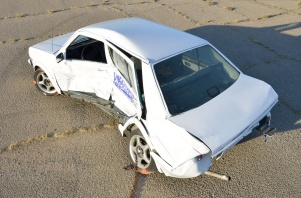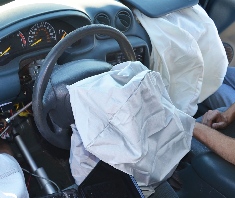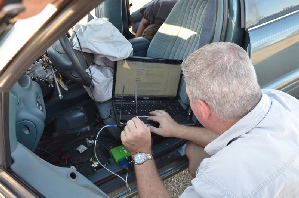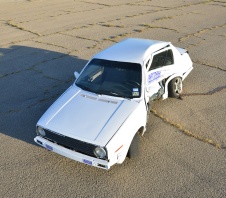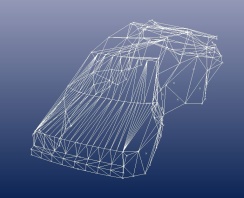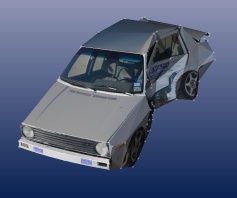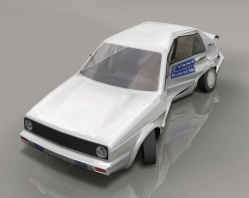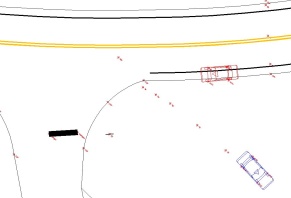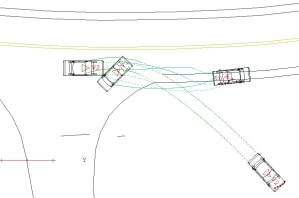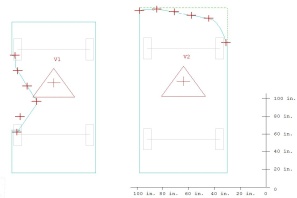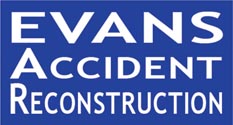
Office (979) 703-7227
Fax (979) 703-7247
24-Hour Crash Response (979) 575-9422
Accident Reconstruction Example
Here is an exmple of an accident
reconstruction based on a fictitious accident, which we will use to
describe some of the techniques and tools used to perform an a
actual accident reconstruction and to answer common questions. The
vehicles photographed are vehicle that were utilized in an Evans
Accident Reconstruction crash demonstration. This is a simplified
explanation for educational purposes; an actual accident
reconstruction is usually much more complex and goes into many more
factors than are described here.
Our fictitious automobile accident occurred on Tabor Road, near the
intersection with Alexander Road, in Bryan, Texas. Mr. Smith was
driving a 1997 Pontiac Grand Am southbound on Tabor Road. A 1991
Volkswagen Jetta driven by Mr. Klaus was making a right turn from
Alexander Road onto Tabor Road when the vehicles collided.
Some time had passed since the accident, and there was no debris or
tire marks present on the roadway. There were orange police paint
marks on the roadway marking the Area of Impact (AOI). There was
also police paint marking the areas where the vehicles came to rest,
both on and off the roadway. The evidence and the roadway were
measured with survey equipment. Other items of interest such as
telephone poles (often used as reference points in police
measurements), buildings (where potential witnesses may have been
watching), and potential visibility obstructions (such as signs,
trees, etc) were also surveyed. Photographs were taken to document
the accident site.
A scaled drawing of the accident scene was then drawn in AutoCAD:
Next the vehicles were inspected. The vehicles were photographed to document the damage and other factors that could prove to be important. At this stage, if a vehicle has an airbag system that records data, and permission to download the vehicle is granted, then the data is downloaded, as it was in this case.
Sometimes there is a potential issue with a
vehicle that could have played a role in the accident, such as a
tire, steering, or brake failure. In those cases a more detailed inspection may be performed in which vehicle
components are thoroughly examined.
Each case is handled differently depending on
the nature of the accident. The amount of crush on a vehicle can be
measured to help calculate the forces at impact, such as speeds at
impact. The amount of crush can also be measured using photographs
and a photogrammetry program like PhotoModeler.
At this point in the reconstruction, the vehicles are drawn to scale and placed into contact positions based on their damages.
The vehicles can also be placed in their rest
positions as measured at the accident site.
Vehicle data is entered into a computer program
that can take into account the energy used to crush a vehicle at
impact, momentum, and vehicle drag factors (the friction slowing the
vehicles down on and off the roadway). Using the known impact position and rest positions, the
computer model can be run to find the speeds of each vehicle at
impact.
Hand calculations can be performed to verify
that the speeds from the computer model are reasonable. The computer
model can also be compared with data that may be stored in the
vehicle.
Once impact speeds are known, the focus turns to the vehicles’
movements prior to impact. Is there driver or witness testimony? Any
evidence of braking on the roadway? A multitude of factors are
considered.
Once the accident variables are understood, a report may be written
to document the findings. The report may then be submitted to the
court as the expert witness report.
A computer simulation animation, a very powerful tool for
communicating different aspects of an accident, may be made. In
animations, difficult time and distance concepts can be made clear.
Views can be shown from inside a model of a vehicle to show what the
driver could or could not have seen, and vehicle damages and motion
can be illustrated. They can be invaluable in helping jurors clearly
“see” an accident.
Click image above to play video
Click here for smaller, lower-quality
video
suitable for slower internet connections


